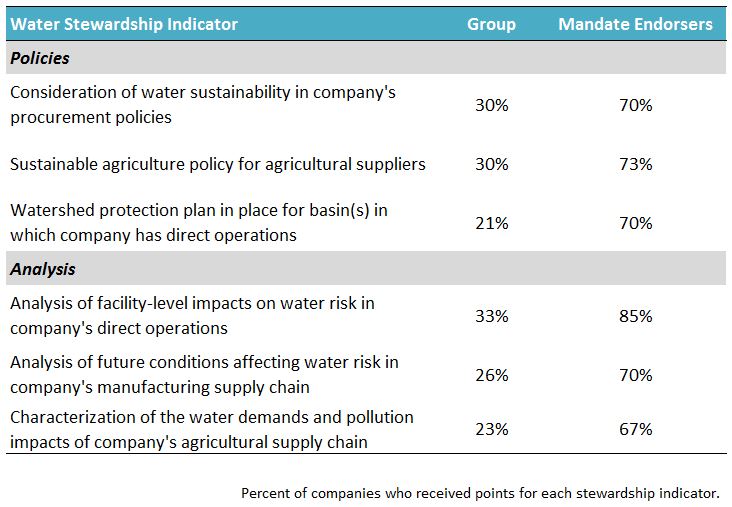CEO Water Mandate Endorsers Come Out on Top in New Ceres Assessment
“For food companies, water management is a business imperative like never before.”
About 10 percent of all endorsers of the CEO Water Mandate are in the food and beverage sectors. The 2017 Feeding Ourselves Thirsty report showed that those endorsers are leading the industry when it comes to water stewardship. CEO Water Mandate-endorsing companies were featured as seven of the top 10 scoring companies in this analysis done by sustainability nonprofit Ceres.
Nestlé, an endorsing company since 2012, achieved the highest score (82 out of 100 possible points), followed by Unilever with 73 points and Coca-Cola with 72. Overall, 13 of the top 20 companies are endorsers of the CEO Water Mandate.
Food companies face unique challenges when it comes to water stewardship because water is a direct input into their product. For beverage companies especially, water makes up most (if not all) of their product – and it takes about three units of water to produce each unit of beverage. Food and beverage companies both encounter risks from, and contribute to, water scarcity conditions – 70 percent of the world’s freshwater use goes to growing crops, feeding livestock, and processing ingredients. This Ceres report is a comprehensive evaluation of how the largest U.S.-based food companies are responding to water risk.
The report looks at four sectors: packaged food, beverage, meat, and agriculture. Companies were scored across 41 indicators within four categories of water management: governance and strategy, direct operations, manufacturing supply chain, and agricultural supply chain. These categories align closely with the six commitment areas of the CEO Water Mandate. Looking through the data (xls), three important trends emerge in Ceres’ analysis:
- Mandate-endorsing companies have leading scores across all four categories
- Scores for the industry as a whole have improved since 2015
- There remain areas in which all companies need to improve
Mandate Endorsers lead in water stewardship across the board
On average, Mandate-endorsing companies performed 25 percent better than the group as a whole. There are also some specific areas where endorsers stand out for their success.
Sustainability Policies and Plans
Most endorsers in this study have explicit policies and watershed protections plans in place, in operations and supply chains, to ensure consideration of water sustainability in decision-making.
Analysis of Impacts and Conditions
Endorsers in this study perform are good at analyzing and characterizing water-related risks to their business, at their facilities and in their supply chains.
The industry has improved over time
Companies have made notable advancements since the assessment was first performed in 2015 – scores improved by 10 percent on average across sectors. The biggest areas of improvement have been in water accounting and target-setting. Sixty two percent of the companies are disclosing at least water withdrawal and discharge volumes. Fifty five percent have set goals to source at least two of their agricultural products sustainably in regard to water.
We still have work to do
Governance and collective action on water are two categories in which all companies are still lacking. There is major room for improvement on incorporating water stewardship into company strategy – particularly when it comes to finance. Just nine percent of these companies translate water risk into financial terms. Putting a dollar value on water-related issues is critical to board level buy-in and oversight, which only 13 percent of companies have currently.
Collective action is another weak spot, and one that is vital to water as it is a shared, localized resource on which every single person in the world relies. Only nine of the evaluated companies have developed collaborative engagement plans for watersheds they source from or operate in. All nine are Mandate endorsers – collective action is a major emphasis of the Mandate’s work. More companies need to partner with each other and other stakeholders to tackle water challenges, particularly at the watershed level.
This report highlighted that the food industry is a critical arena for water stewardship work. Many of these companies still have a long way to go on their water stewardship journey, but the progress seen in the past two years since the initial Feeding Ourselves Thirsty report is a good start. Let’s continue to build on this momentum! If your company is interested in joining the community of CEO Water Mandate endorsers, you can find out more here.

